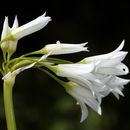en
names in breadcrumbs


Allium triquetrum is a bulbous flowering plant in the genus Allium (onions and garlic) native to the Mediterranean basin. It is known in English as three-cornered leek, in Australia as angled onion[4] and in New Zealand as onion weed.[5] Both the English name and the specific epithet triquetrum refer to the three-cornered shape of the flower stalks.[6]
Allium triquetrum produces stems 17–60 cm (6+3⁄4–23+1⁄2 in) tall, which are concavely triangular in cross-section. Each stem produces an umbel inflorescence of 4–19 flowers in January–May in the species' native environment.[7] The tepals are 10–18 mm (13⁄32–23⁄32 in) long and white, but with a "strong green line".[8] Each plant has two or three narrow, linear leaves, each up to 15 cm (6 in) long.[7] The leaves have a distinct onion smell when crushed.
Allium triquetrum is native to south-western Europe, north-western Africa, Madeira and the Canary Islands, where it grows in meadows, woodland clearings, on river banks and roadside verges from sea level to an elevation of 850 metres (2,790 ft).[7] It has also been introduced to Great Britain, Ireland, New Zealand, Turkey, Australia, California, Oregon, and South America,[7][9] and is a declared noxious weed in some of those places.[10] It has been recorded as an alien at a garden waste site on Howth Head, Ireland.[11]
All parts of the plant, from the bulb to the flowers, are edible fresh or cooked.[12]
Allium triquetrum is a bulbous flowering plant in the genus Allium (onions and garlic) native to the Mediterranean basin. It is known in English as three-cornered leek, in Australia as angled onion and in New Zealand as onion weed. Both the English name and the specific epithet triquetrum refer to the three-cornered shape of the flower stalks.